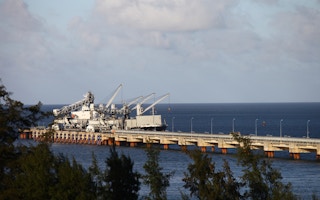Hanoi already knows what caused the massive fish kill that devastated the country’s central coast, but has yet to release the information to the public, a noted Vietnamese oceanographer told RFA’s Vietnamese Service.
“Everybody agreed, and even the government knows what the root problem is from the waste, and they know where to find the source of waste,” Nguyen Tac An, the former director of Nha Trang Institute of Oceanography told RFA. “However, to announce the name of the source is the government’s decision.”
The government’s handling of the situation has raised more questions than answers. In late April, government officials said they didn’t know the cause of the fish kill, but they blamed it on a red tide or “a chemical toxin generated by people on land or sea.”
Since then, Hanoi has appeared to back off its statements, and Vietnamese Prime Minister Nguyen Xuan Phuc has vowed to investigate any agency, organisation or individual that violated the nation’s environmental laws.
And last week, Vietnam’s top environment official apologised for the government’s “confused” handling of the disaster that has killed tons of fish across a wide swath of the country’s central coast.
While the Phuc government may be looking for someone to blame, An told RFA that scientists already know what killed the fish.
“Scientists have found out how much waste there was, and how toxic it was,” he said. “They have satellite pictures from April 6 to April 20 to back up what they calculated.”
A Fishgate scandal
Not only is the fish kill that originated near the industrial port of Vung Ang an environmental disaster that threatens Vietnam’s vital seafood industry, it is developing into a major political scandal for Phuc.
The disaster doesn’t just have coastal dwellers up in arms, demonstrations have occurred in the streets of major cities as Vietnamese have rallied around the issue.
While Phuc has promised a thorough investigation into the disaster, he has also promised to deal harshly with those who want to use the scandal to stir up trouble for the government. Two people were arrested this week for allegedly trying to incite Vietnamese to demonstrate over the fish kill.
The disaster didn’t have to play out the way it did, An said.
“When the incident happened, scientists came up with many proposed methods to look for the causes,” he said. “But in Vietnam this matter is sensitive, so it is the government’s decision to publish the results including satellite pictures.”
While the government’s handling of the disaster is open to question, An said that the nation’s scientists are largely in agreement over the cause.
“Scientists have found the causes of environmental crisis in Vung Ang, and they already had a prediction of how this would spread and what the ecological consequences would be,” he said.
Up to Hanoi
While scientists might know the cause, it’s up to Hanoi to reveal it, he said.
“This is the government’s decision, not the scientists’ decision,” he said. “Scientifically we are not as developed as other countries like the US, Germany, Russia or France, but we do have enough knowledge to find the causes and have specific data to back up what we found.
“
They are frustrated because of the slow response. They want to know why Formosa is allowed to release their wastewater to the sea.
Le Dang Doanh, economist, Vietnam
Hanoi asked for help on the disaster from nations around the world, but An said he doubted their results will differ from what Vietnamese experts have discovered.
Since the disaster first began to unfold in early April, much of the attention and initial blame for the catastrophe was leveled at the Formosa Ha Tinh Steel Corporation, that operates as a subsidiary of Formosa Plastics Corporation.
Vietnamese divers reportedly observed a huge discharge of reddish liquid on April 4 from the mouth of a mile-long waste water pipe leading from Formosa’s $10.5 billion steel mill and port facility in Vung Ang.
Formosa has stated flatly that all of its activities comply with Vietnamese laws and regulations, and that it had spent $45 million on a state-of-the-art waste management system, including the four-foot wide pipe.
A frustrated people
As information about the disaster has slowly leaked out, Vietnamese are beginning to get frustrated with the government and its apparently cosy relationship with Formosa, said Le Dang Doanh, one of the country’s leading economists.
“They are frustrated because of the slow response,” Doanh told RFA. “They want to know why Formosa is allowed to release their wastewater to the sea. Why the environmental agency of Ha Tinh province signed a contract to let Formosa test their own wastewater. And, of course, why that office always says that their wastewater meets the acceptable standards.”
Doanh, a former advisor to the Ministry of Planning and Investments, said it looks like the government sent “the fox to mind the geese” in Vung Ang.
“That is the reason why Ha Tinh province government can’t answer questions about Formosa’s importation of tonnes of chemicals to clean their pipeline and release it to the sea; when they did it; and how much was released.”
Copyright © 1998-2014, RFA. Used with the permission of Radio Free Asia, 2025 M St. NW, Suite 300, Washington DC 20036.










